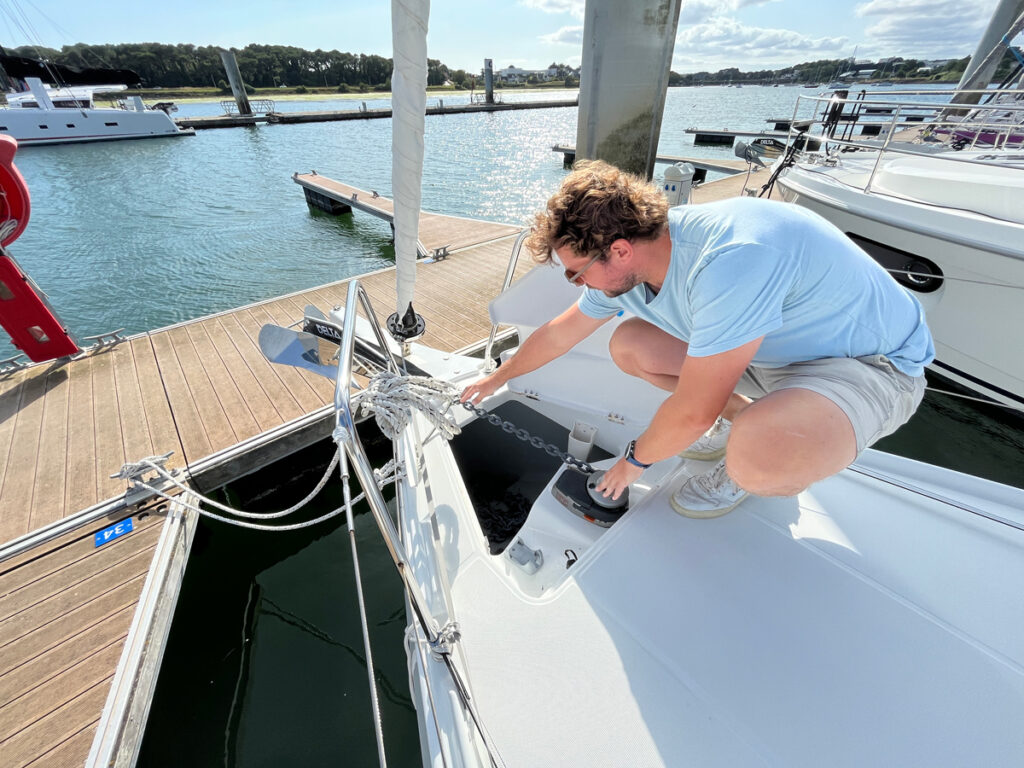All boat rentals, whether with or without a skipper, require an inventory before the boat leaves port. This step, often a little tedious and shortened by many yachtsmen, is actually a crucial part of your cruise and can certainly affect its outcome.
In the event of a defect or problem on board, that has not been recorded, it will be difficult for you to contest an inventory that you have signed. Be aware, however, that if you observe a lack of maintenance or wear that was omitted during the inventory, you should immediately notify the base manager by telephone/email. Do not hesitate to take a photo/video of the elements concerned.
Once you have completed your formalities with the base manager, it is time to board the boat and start your inventory before setting sail. Thanks to the documents provided by the rental company (touch pad or sheets to be completed) you will be able to carry out an inventory of the boat in complete autonomy. Do not hesitate to speak to a technician on the pontoon if any points do not seem clear to you – regarding both the boat’s equipment and the navigation instruments. Allow at least 1 hour for a good inventory of your boat, to be able to cast off with peace of mind!
If you rent the boat with a professional skipper, we recommend that you get help from the skipper, this will save you time, and it will also be very useful for him to get to know the boat before boarding. However, please be aware that it is your responsibility to sign the inventory, not the skipper, because the rental contract is in your name and it is your deposit that guarantees the rental.
We can divide the inventory into two parts; the exterior of the boat, and the interior of the boat.
1_ Inventory for the EXTERIOR of the boat
After examining the exterior of the boat to see the general condition of the hull and rigging, we strongly advise you, if the wind allows it, to hoist the mainsail to check its condition, ensure that there is no tearing and that the slats and sliders are all in place.
Start the engine. Run it and check that no white smoke appears. Test the forward and reverse motion of the boat. And check the fuel gauge (if it works!) and if the level is correct.
Take the opportunity to check that the water tanks are full, the location of the deck fillers, and that a key is present on board… Also remember to check the presence of the tender’s outboard motor nurse!
Finally, we invite you to test the windlass in order to avoid unpleasant surprises when you arrive at your first anchorage!
Do not forget to take note of the draft of the boat. And test the sounder. We can only advise you to be very vigilant and take a safety margin of one meter of water under the keel.
2_ Inventory for the INTERIOR of the boat
It is not a question of counting the forks or checking that everyone has a bowl or the state of cleanliness of the oven, the goal is to focus on the main elements to be checked and this concerns the safety of the boat and all onboard.
Find and check the valves on the boat and test the proper functioning of all toilets.
Study the composition of the toolkit. Unfortunately, they are often poorly supplied. We advise you to bring a few basic personal tools that are essential (pliers, shackle puller, letherman, etc.) A harness or a mast chair can also be a good help if it is necessary to climb the mast.
Do not forget to check the safety elements (fog horn, spare strap, flashlight, first aid kit) then of course take the time to find and count the life jackets on board.
It is also useful to check the presence of binoculars, compass, Cras ruler and paper maps of your navigation area. Also note and remember the location of the boat papers with contact details of the base or boat owner.
Ask for advice, if necessary, for the use of the gas stove and weigh the gas cylinders present on board.
Finally, take the time to check the batteries and their operation, to recharge them efficiently. And we also advise you to check the general condition of the engine (oil and coolant level) and the bilges of the boat.
That’s it, you now know how to properly prepare your boat rental.
Congratulations if you have managed to take the time necessary to follow these steps, you put the odds on your side to cast off with peace of mind. Last advice, for the first sail, take the time to experience the boat (and its crew!) without going too far from the port on the first day, in order to check that everything is going well on board.
Happy browsing everyone!




